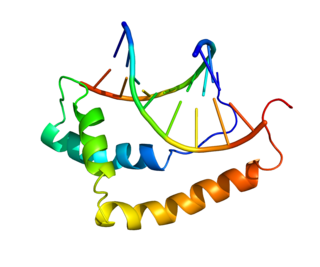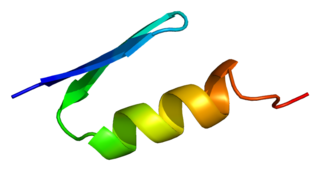
The X chromosome is one of the two sex chromosomes in many organisms, including mammals, and is found in both males and females. It is a part of the XY sex-determination system and XO sex-determination system. The X chromosome was named for its unique properties by early researchers, which resulted in the naming of its counterpart Y chromosome, for the next letter in the alphabet, following its subsequent discovery.

A germ cell is any cell that gives rise to the gametes of an organism that reproduces sexually. In many animals, the germ cells originate in the primitive streak and migrate via the gut of an embryo to the developing gonads. There, they undergo meiosis, followed by cellular differentiation into mature gametes, either eggs or sperm. Unlike animals, plants do not have germ cells designated in early development. Instead, germ cells can arise from somatic cells in the adult, such as the floral meristem of flowering plants.
David C. Page is an American biologist and professor at the Massachusetts Institute of Technology (MIT), the director of the Whitehead Institute, and a Howard Hughes Medical Institute (HHMI) investigator. He is best known for his work on mapping the Y-chromosome and on its evolution in mammals and expression during development.

Sex-determining region Y protein (SRY), or testis-determining factor (TDF), is a DNA-binding protein encoded by the SRY gene that is responsible for the initiation of male sex determination in therian mammals. SRY is an intronless sex-determining gene on the Y chromosome. Mutations in this gene lead to a range of disorders of sex development with varying effects on an individual's phenotype and genotype.

Spermatocytes are a type of male gametocyte in animals. They derive from immature germ cells called spermatogonia. They are found in the testis, in a structure known as the seminiferous tubules. There are two types of spermatocytes, primary and secondary spermatocytes. Primary and secondary spermatocytes are formed through the process of spermatocytogenesis.

Y linkage, also known as holandric inheritance, describes traits that are produced by genes located on the Y chromosome. It is a form of sex linkage.

The synaptonemal complex (SC) is a protein structure that forms between homologous chromosomes during meiosis and is thought to mediate synapsis and recombination during prophase I during meiosis in eukaryotes. It is currently thought that the SC functions primarily as a scaffold to allow interacting chromatids to complete their crossover activities.

A chromomere, also known as an idiomere, is one of the serially aligned beads or granules of a eukaryotic chromosome, resulting from local coiling of a continuous DNA thread. Chromomeres are regions of chromatin that have been compacted through localized contraction. In areas of chromatin with the absence of transcription, condensing of DNA and protein complexes will result in the formation of chromomeres. It is visible on a chromosome during the prophase of meiosis and mitosis. Giant banded (Polytene) chromosomes resulting from the replication of the chromosomes and the synapsis of homologs without cell division is a process called endomitosis. These chromosomes consist of more than 1000 copies of the same chromatid that are aligned and produce alternating dark and light bands when stained. The dark bands are the chromomere.

Wilms tumor protein (WT33) is a protein that in humans is encoded by the WT1 gene on chromosome 11p.

Early growth response protein 2 is a protein that in humans is encoded by the EGR2 gene. EGR2 is a transcription regulatory factor, containing three zinc finger DNA-binding sites, and is highly expressed in a population of migrating neural crest cells. It is later expressed in the neural crest derived cells of the cranial ganglion. The protein encoded by Krox20 contains two cys2his2-type zinc fingers. Krox20 gene expression is restricted to the early hindbrain development. It is evolutionarily conserved in vertebrates, humans, mice, chicks, and zebra fish. In addition, the amino acid sequence and most aspects of the embryonic gene pattern is conserved among vertebrates, further implicating its role in hindbrain development. When the Krox20 is deleted in mice, the protein coding ability of the Krox20 gene is diminished. These mice are unable to survive after birth and exhibit major hindbrain defects. These defects include but are not limited to defects in formation of cranial sensory ganglia, partial fusion of the trigeminal nerve (V) with the facial (VII) and auditory (VII) nerves, the proximal nerve roots coming off of these ganglia were disorganized and intertwined among one another as they entered the brainstem, and there was fusion of the glossopharyngeal (IX) nerve complex.

Testis-specific Y-encoded protein 1 is a protein that in humans is encoded by the TSPY1 gene.

Transcription factor SOX-9 is a protein that in humans is encoded by the SOX9 gene.

Lysine-specific demethylase 5D is an enzyme that in humans is encoded by the KDM5D gene. KDM5D belongs to the alpha-ketoglutarate-dependent hydroxylases superfamily.

Zinc finger X-chromosomal protein is a protein that in mammals is encoded by the ZFX gene of the X chromosome.

Rex1 (Zfp-42) is a known marker of pluripotency, and is usually found in undifferentiated embryonic stem cells. In addition to being a marker for pluripotency, its regulation is also critical in maintaining a pluripotent state. As the cells begin to differentiate, Rex1 is severely and abruptly downregulated.

Kelch domain-containing protein 3 is a protein that in humans is encoded by the KLHDC3 gene.

Transcriptional repressor CTCFL also known as BORIS is a protein that in humans is encoded by the CTCFL gene.

The meiotic recombination checkpoint monitors meiotic recombination during meiosis, and blocks the entry into metaphase I if recombination is not efficiently processed.

PR domain zinc finger protein 9 is a protein that in humans is encoded by the PRDM9 gene. PRDM9 is responsible for positioning recombination hotspots during meiosis by binding a DNA sequence motif encoded in its zinc finger domain. PRDM9 is the only speciation gene found so far in mammals, and is one of the fastest evolving genes in the genome.

DNA ligase 3 also DNA ligase III, is an enzyme that, in humans, is encoded by the LIG3 gene. LIG3 encodes ATP-dependent DNA ligases that seal interruptions in the phosphodiester backbone of duplex DNA.
























